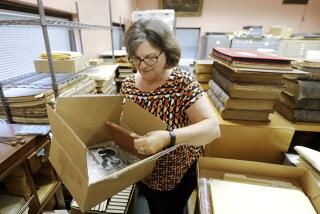New Insight Into Mind of Archimedes
- Share via
CHICAGO — Once thought to be lost forever, a 1,000-year-old parchment manuscript containing the works of Archimedes is being preserved and studied for insights into one of the greatest minds of the ancient world.
The book, which scholars believe was copied by a scribe in the 10th century from Archimedes’ original scrolls, was bought anonymously at auction for $2 million last year.
It is being displayed at the Field Museum in Chicago until Jan. 3, when it will be returned to the Walters Art Gallery in Baltimore for restoration.
The manuscript is the only copy in the original Greek of Archimedes’ theory of flotation of bodies. The text and diagrams also detail his mathematical treatises and mechanical theorems and contain the roots of modern calculus and gravitational theory.
“What this does is broaden the base of our understanding of the mainstream of Western mathematical historical tradition,” said William Noel, the gallery’s curator. “We can understand the tradition of thought.”
Archimedes, born in Sicily in 287 BC, is credited with discovering the principle of water displacement while sitting in his bath. He also invented the pulley and a planetarium that demonstrated the movement of the stars.
About 200 years after the book was written, the text and diagrams were erased by scraping the skin, and the leaves were cut and reused in a smaller book of Christian prayers. New words were written across the original text, which still shows up faintly.
The book disappeared around 1923 from a monastery in Constantinople. It resurfaced in the possession of a French family in the 1930s and was sold by the family last year.
The manuscript survived a fire, which parched the edges, and has also been damaged by mold.
The manuscript is called the Archimedes Palimpsest. Palimpsest is writing material that has been reused by erasing earlier writing.
Restoration is expected to last four or five years. After the pages are carefully removed and cleaned, the text must be read to learn the original order of the pages. Digital scanners and ultraviolet light will allow scholars to read the text and diagrams.
The possibility of finding new theorems in the manuscript, though remote, is intriguing, said Field Museum librarian Benjamin Williams.
“That would be quite significant in the mathematical world,” he said. “It is an unknown, and that’s what’s so thrilling about this.”
More to Read
Sign up for Essential California
The most important California stories and recommendations in your inbox every morning.
You may occasionally receive promotional content from the Los Angeles Times.











